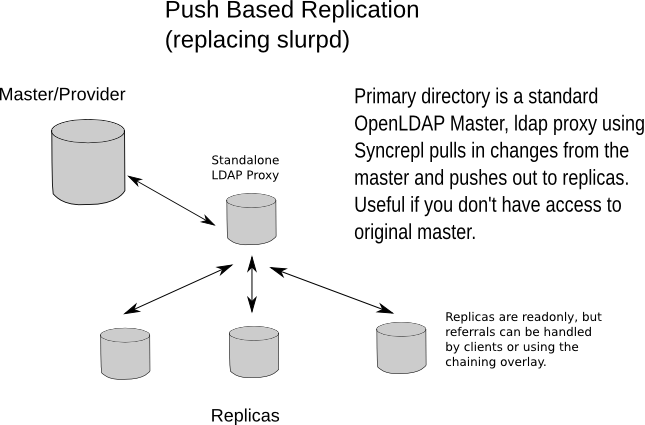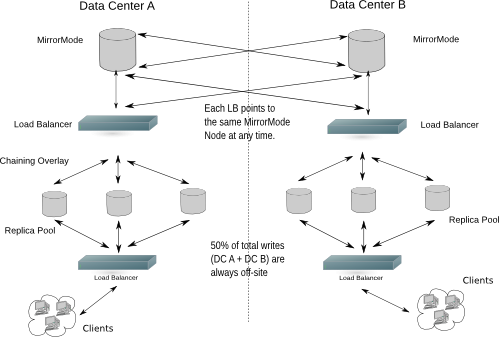Introduction to LDAP Replication
Table of Contents
Date: 09-16-2024
Overview
Replication is an essential tool to allow multiple servers to maintain up-to-date information between many changing systems. From simply one primary machine updating a secondary machine, multiple primary machines updating each other, or multiple primary machines updating a numerous amount of secondary machines; replicated directories are a fundamental requirement for delivering a resilient enterprise deployment.
When an LDAP Directory Service is set up, it can have one, several, or or many servers responding to requests.
If more than one server is handling the load, changes made to any server have to be propagated to the others so each has a complete and up to date copy of the directory's data. Propagating changes is called replication.
Changes are requested by authorized LDAP Client programs or utility programs and are sent to one of the servers. Wherever and however the request gets to a server, it processes it and sends the results (data or a result code) back.
But those changes need to be replicated to the rest of the servers. The the IETF standards specify that an LDAP implementation MUST provide replication of changes. OpenLDAP provides sophistication for replication.
Types of Replication
LDAP Sync Replication
The replication engine,

Syncrepl uses the LDAP Content Synchronization protocol (or LDAP Sync for short) as the consumer synchronization protocol. LDAP Sync provides a stateful replication which supports both pull-based and push-based synchronization and does not mandate the use of a history store. In pull-based replication the consumer periodically polls the provider for updates. In push-based replication the consumer listens for updates that are sent by the provider in realtime. Since the protocol does not require a history store, the provider does not need to maintain any log of updates it has received (Note that the syncrepl engine is extensible and additional replication protocols may be supported in the future.).
Syncrepl keeps track of the status of the replication content by maintaining and exchanging synchronization cookies. Because the syncrepl consumer and provider maintain their content status, the consumer can poll the provider content to perform incremental synchronization by asking for the entries required to make the consumer up-to-date with the provider content. Syncrepl also enables convenient management of consumers by maintaining replication status. The consumer database can be constructed from a consumer-side or a provider-side backup at any synchronization status. Syncrepl can automatically resynchronize the consumer database to be up-to-date with the current provider content.
Syncrepl supports both pull-based and push-based synchronization. In its basic refreshOnly synchronization mode, the provider uses pull-based synchronization where the consumer servers need not be tracked and no history information is maintained. The information required for the provider to process periodic polling requests is contained in the synchronization cookie of the request itself. To optimize the pull-based synchronization, syncrepl utilizes the present phase of the LDAP Sync protocol as well as its delete phase, instead of falling back on frequent full reloads. To further optimize the pull-based synchronization, the provider can maintain a per-scope session log as a history store. In its refreshAndPersist mode of synchronization, the provider uses a push-based synchronization. The provider keeps track of the consumer servers that have requested a persistent search and sends them necessary updates as the provider replication content gets modified.
With syncrepl, a consumer can create a replication agreement without changing the provider's configurations and without restarting the provider server, if the consumer server has appropriate access privileges for the DIT fragment to be replicated. The consumer server can stop the replication also without the need for provider-side changes and restart.
Syncrepl supports partial, sparse, and fractional replications. The shadow DIT fragment is defined by a general search criteria consisting of base, scope, filter, and attribute list. The consumer content is also subject to the access privileges of the bind identity of the syncrepl replication connection.
Delta-syncrepl Replication

Delta-syncrepl, a changelog-based variant of syncrepl, is designed to address situations like the one described above. Delta-syncrepl works by maintaining a changelog of a selectable depth in a separate database on the provider. The replication consumer checks the changelog for the changes it needs and, as long as the changelog contains the needed changes, the consumer fetches the changes from the changelog and applies them to its database. If, however, a consumer is too far out of sync (or completely empty), conventional syncrepl is used to bring it up to date and replication then switches back to the delta-syncrepl mode.
N-Way Multi-Provider Replication

Multi-Provider replication is a replication technique using Syncrepl to replicate data to multiple provider ("Provider") Directory servers. The four main reasons to use n-way multi-provider replication are: if any provider fails, other providers will continue to accept updates, it avoids a single point of failure, providers can be located in several physical sites such as distribution across the network/globe, and good for automatic failover/high availability.
Mirror-Mode Replication

MirrorMode is a hybrid configuration that provides all of the consistency guarantees of single-provider replication, while also providing the high availability of multi-provider. In MirrorMode two providers are set up to replicate from each other (as a multi-provider configuration), but an external frontend is employed to direct all writes to only one of the two servers. The second provider will only be used for writes if the first provider crashes, at which point the frontend will switch to directing all writes to the second provider. When a crashed provider is repaired and restarted it will automatically catch up to any changes on the running provider and resync.
Syncrepl Proxy Mode

While the LDAP Sync protocol supports both pull- and push-based replication, the push mode (refreshAndPersist) must still be initiated from the consumer before the provider can begin pushing changes. In some network configurations, particularly where firewalls restrict the direction in which connections can be made, a provider-initiated push mode may be needed.
This mode can be configured with the aid of the LDAP Backend (Backends and slapd-ldap(8)). Instead of running the syncrepl engine on the actual consumer, a slapd-ldap proxy is set up near (or collocated with) the provider that points to the consumer, and the syncrepl engine runs on the proxy.